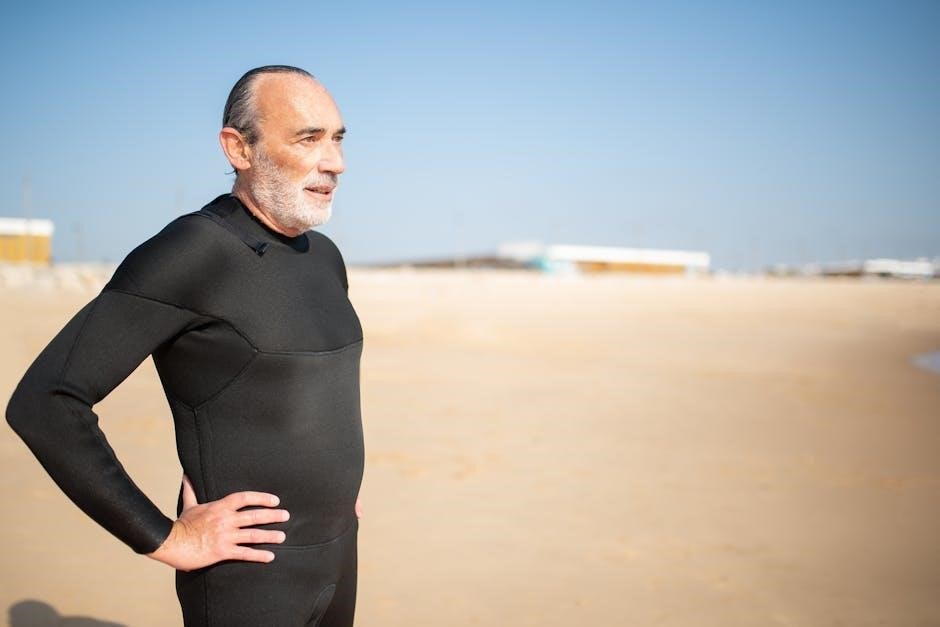the old man and sea pdf
The Old Man and the Sea is a timeless novella by Ernest Hemingway, published in 1952. It tells the story of an aging fisherman’s journey, exploring themes of perseverance and human struggle against nature. The book is widely available in PDF format for readers seeking a digital copy, making it easily accessible for study and enjoyment. Its enduring appeal lies in its profound simplicity and universal themes, continuing to captivate audiences worldwide.
Overview of the Novella
The Old Man and the Sea is a novella by Ernest Hemingway, published in 1952. It tells the story of Santiago, an aging fisherman, and his epic journey to catch a giant marlin off the coast of Cuba. The novella is celebrated for its simplicity, depth, and universal themes. Hemingway’s concise prose and focus on human resilience make it a masterpiece of 20th-century literature. The story explores Santiago’s physical and emotional struggles, as well as his connection to nature and humanity. Its popularity has led to widespread availability, including PDF versions, making it accessible to readers worldwide. The novella has won numerous awards, including the Pulitzer Prize, and remains a cornerstone of Hemingway’s legacy. Its enduring appeal lies in its ability to inspire reflection on perseverance, hope, and the human condition.
Significance of the Title
The title The Old Man and the Sea carries profound symbolic weight, reflecting the novella’s central themes of human resilience and the eternal struggle between man and nature. The “old man” represents experience, perseverance, and the human condition, while the “sea” embodies the vast, uncontrollable forces of life. Together, they symbolize the universal journey of individuals facing challenges beyond their control. The simplicity of the title mirrors Hemingway’s concise writing style, emphasizing the core elements of the story. It also highlights the deep, almost spiritual connection between Santiago and the natural world, suggesting that the old man’s struggle is not just physical but existential. The title’s brevity and clarity make it timeless, inviting readers to reflect on their own struggles and the inevitability of life’s trials. This duality of human frailty and natural grandeur is central to the novella’s enduring appeal.
Ernest Hemingway’s Writing Style

Ernest Hemingway’s writing style in The Old Man and the Sea is characterized by simplicity, clarity, and a focus on concrete, descriptive details. His minimalist approach avoids elaborate descriptions, instead relying on direct, concise language to convey deep emotional and philosophical themes. Hemingway’s prose is sparse yet powerful, reflecting his journalistic background and the “iceberg theory,” where much of the story’s meaning lies beneath the surface. This style creates a sense of immediacy and intimacy, drawing readers into the old man’s world. The novella’s short sentences and straightforward dialogue enhance its accessibility, while the vivid imagery of the sea and its creatures underscores the struggle between humanity and nature. Hemingway’s unique voice has made The Old Man and the Sea a timeless classic, resonating with readers in both print and PDF formats.
Plot Summary
Santiago, an aging fisherman, embarks on a journey to catch a giant marlin after 84 days without success. His determination is tested as he battles the marlin and confronts sharks, leading to a tragic conclusion.
Setting of the Story

The story of The Old Man and the Sea is set in a small fishing village near Havana, Cuba, during the mid-20th century. The novella unfolds in two primary locations: the village and the Gulf of Mexico. The village serves as a backdrop for Santiago’s daily life, highlighting his isolation and the community’s perception of him as unlucky. The sea, however, is the central setting, symbolizing both beauty and brutality. Santiago’s journey takes him far into the Gulf, where he battles a giant marlin, emphasizing the vastness and power of nature. The setting plays a crucial role in shaping the story’s themes, particularly the struggle between humanity and the natural world. The vivid descriptions of the sea and its creatures create a sense of realism, immersing readers in Santiago’s world. The time period is not explicitly stated but reflects Hemingway’s contemporary era, adding to the novella’s timeless appeal.
Main Characters and Their Roles
The novella The Old Man and the Sea revolves around a few central characters, each playing a vital role in the story’s development. Santiago, the aging fisherman, is the protagonist whose determination and resilience drive the narrative. His journey symbolizes the human struggle against nature and fate. The Giant Marlin represents both a challenge and a symbol of Santiago’s unwavering spirit. Their confrontation is central to the story, highlighting themes of perseverance and respect for nature. Manolin, the young boy, serves as a source of support and hope for Santiago. Despite his absence for most of the story, Manolin’s loyalty and admiration for Santiago underscore the bond between generations and the passing of wisdom. Together, these characters create a profound exploration of human endurance and the interconnectedness of life and nature.
Key Events and Turning Points
The novella The Old Man and the Sea unfolds through several pivotal events that shape Santiago’s journey. After 84 days without catching a fish, Santiago ventures far into the Gulf Stream, determined to break his unlucky streak. His encounter with a giant marlin marks a turning point, as he battles the creature for three days, showcasing his resilience and determination. Despite his physical exhaustion, Santiago manages to kill the marlin, symbolizing his triumph over nature. However, his victory is short-lived, as sharks devour the marlin’s carcass, leaving only its skeleton. Santiago’s return to shore with the marlin’s bones signifies both defeat and admiration for his perseverance. These events highlight the struggle between humanity and nature, emphasizing themes of courage, sacrifice, and the inevitability of loss. The story’s climax underscores Santiago’s unwavering spirit, making him a legendary figure in his village.

Themes in “The Old Man and the Sea”

Perseverance and Determination
The novella highlights Santiago’s unwavering resolve, showcasing how determination fuels his quest despite adversity, reflecting the human spirit’s capacity to endure hardship.
Isolation and Loneliness
Santiago’s solitude at sea symbolizes the universal experience of isolation, emphasizing the duality of loneliness as both a burden and a source of introspective strength.
The Struggle Between Man and Nature
The story explores the eternal conflict between humanity and the natural world, illustrating respect for nature’s power while affirming the resilience of the human spirit in its face.

Perseverance and Determination
Perseverance and determination are central themes in The Old Man and the Sea, as embodied by Santiago, the aging fisherman. Despite enduring 84 days without catching a fish, Santiago remains resolute in his pursuit, reflecting Hemingway’s emphasis on grit and resilience. His journey symbolizes the human spirit’s capacity to endure adversity, even in the face of overwhelming odds. Santiago’s determination is not merely about catching the giant marlin but about proving his worth and defying the perception of his decline. Through his relentless effort, Hemingway highlights the importance of perseverance as a means to maintain dignity and purpose. The novella underscores that true strength lies not in the outcome but in the courage to persist. This theme resonates deeply with readers, making The Old Man and the Sea a timeless exploration of the human will to endure. The PDF version of the novella allows readers to delve into this inspiring tale of determination and resilience.
Isolation and Loneliness
The theme of isolation and loneliness is central to The Old Man and the Sea, as Santiago’s journey reflects his emotional and physical solitude. Living in a small Cuban village, Santiago is often viewed as unlucky and isolated by the community, further emphasizing his loneliness. His relationship with the boy Manolin, who cares for him deeply, provides a contrast to his otherwise solitary existence. During his epic struggle with the marlin, Santiago’s isolation is profound, yet it is in this solitude that he finds a deep connection to nature and himself. The novella explores how loneliness can lead to introspection and self-discovery, highlighting Santiago’s resilience and dignity in the face of adversity. This theme resonates deeply with readers, making The Old Man and the Sea a powerful exploration of the human condition.
The Struggle Between Man and Nature
The central theme of The Old Man and the Sea revolves around the eternal conflict between humanity and the natural world. Santiago, the aging fisherman, embodies this struggle as he ventures into the vast, unpredictable sea. The novella highlights the man’s determination to conquer nature, symbolized by his epic battle with the giant marlin. Despite his physical limitations, Santiago shows immense resilience, reflecting humanity’s inherent desire to challenge and understand the forces of nature.
The sea itself is portrayed as both a nurturing and unforgiving entity, providing sustenance while testing Santiago’s endurance. The marlin, a majestic creature, represents the untamed power of nature, which Santiago respects deeply. Their confrontation is not just a physical battle but a metaphorical one, exploring the limits of human will against the indomitable natural world.
Ultimately, the novella suggests that while humans may not always prevail, the struggle itself is a testament to their spirit and connection to the universe. This theme resonates deeply, making The Old Man and the Sea a timeless reflection on human existence and our relationship with nature.

Character Analysis
Santiago, the aging fisherman, embodies resilience and determination. The giant marlin symbolizes his ultimate challenge and pride. Manolin, the young boy, represents hope and loyalty, highlighting Santiago’s paternal bond and legacy. The PDF version delves into these complexities deeply.
The Old Man (Santiago)

Santiago, the protagonist of The Old Man and the Sea, is a weathered fisherman in his late 70s, enduring a long streak of bad luck. His determination and resilience define his character, as he ventures into the Gulf Stream alone, driven by hope and experience. Despite his physical frailty, Santiago embodies a deep connection with nature, respecting and understanding the sea and its creatures. His journey is not just about catching a giant marlin but about confronting his own mortality and the inevitability of life’s struggles. Santiago’s relationship with the boy, Manolin, highlights his paternal instincts and the passing of wisdom. Through his perseverance, Santiago symbolizes the human spirit’s capacity to endure adversity, even in isolation. His story, available in PDF formats for readers, remains a powerful exploration of courage, dignity, and the unyielding will to survive.
The Giant Marlin

The Giant Marlin in The Old Man and the Sea is a monumental symbol of Santiago’s epic struggle. This colossal creature, hooked by the old man after 84 days without a catch, represents the ultimate challenge and the indomitable power of nature. The marlin’s enormous size and strength highlight Santiago’s determination and resilience, as he battles the fish for days, despite his physical limitations. The marlin also embodies the theme of perseverance, as Santiago’s unwavering dedication to his quest reflects his unrelenting spirit. The marlin’s eventual defeat, though tragic, underscores the inevitability of loss and the cyclical nature of life. Through the marlin, Hemingway explores the profound connection between humanity and the natural world, emphasizing both the beauty and the brutality of existence. The marlin’s presence drives the narrative, making it a central element in the novella’s exploration of human struggle and dignity.
The Boy (Manolin)
Manolin, the young boy in The Old Man and the Sea, represents hope, innocence, and the passing of wisdom between generations. Despite his father’s disapproval, Manolin remains devoted to Santiago, the old fisherman, and views him as a mentor. Their bond transcends age, with Manolin showing deep respect and care for Santiago, often bringing him food and supplies. Manolin’s character symbolizes the connection between youth and experience, highlighting themes of loyalty and friendship. His belief in Santiago’s abilities, even when others doubt him, underscores the novella’s exploration of perseverance and faith. Manolin’s presence also serves as a reminder of Santiago’s past and his desire to share his knowledge with the next generation. Through Manolin, Hemingway illustrates the importance of human relationships in overcoming isolation and adversity, making him a pivotal figure in the story’s emotional landscape.
Symbols in the Novella
In The Old Man and the Sea, symbols like the marlin and sharks represent life’s challenges and inevitable destruction. The sea symbolizes the vast, unpredictable nature of existence, reflecting Santiago’s journey and human resilience.
The Marlin as a Symbol
The giant marlin in The Old Man and the Sea serves as a profound symbol, embodying themes of ambition, perseverance, and the human struggle against nature. Santiago’s epic battle with the marlin represents his unwavering determination and the quest for meaning in life. The marlin itself symbolizes the elusive nature of success and the inevitability of loss, as Santiago ultimately loses the fish to sharks. The marlin’s massive size and strength highlight the magnitude of Santiago’s challenge, while its beauty and grace underscore the nobility of the struggle. The marlin also symbolizes Santiago’s pride and redemption, as catching it would validate his worth as a fisherman. Through the marlin, Hemingway explores the idea that true victory lies not in the outcome but in the courage and resilience shown during the journey. The marlin remains a central and enduring symbol of human perseverance in the face of overwhelming adversity.
The Sharks and Their Significance
In The Old Man and the Sea, the sharks symbolize the destructive forces of nature and the inevitability of decay. After Santiago catches the giant marlin, sharks relentlessly attack the carcass, leaving only bones by the end of his journey. This not only underscores the harsh reality of life’s impermanence but also serves as a metaphor for how success and achievement are often fleeting. The sharks represent the natural world’s indifference to human effort, highlighting the struggle between man and nature. Their presence emphasizes Santiago’s courage and resilience, as he accepts the loss of the marlin with dignity. The sharks’ role in the novella reinforces Hemingway’s themes of perseverance and the human condition, illustrating that true victory lies not in material gain but in the journey itself.
The Sea as a Symbol of Life
The sea in The Old Man and the Sea serves as a profound symbol for life itself, embodying its unpredictability, beauty, and relentless challenges. Santiago’s journey across the vast, often harsh waters mirrors the human experience of facing adversity and striving for meaning. The sea’s vastness and depth symbolize the unknown, while its rhythms—calm one moment, turbulent the next—reflect life’s ups and downs. For Santiago, the sea is both a source of sustenance and a test of endurance, much like how life provides opportunities and obstacles. The novella highlights the interconnectedness of humanity and nature, as Santiago’s struggle with the marlin and the sharks underscores the delicate balance between survival and sacrifice. Ultimately, the sea represents the enduring spirit of perseverance, as Santiago’s unwavering dedication to his craft resonates with readers long after the story concludes.
Resources for Reading
Find “The Old Man and the Sea” PDF online through official Hemingway websites, major eBook retailers, or academic platforms. Many libraries and educational sites offer free or discounted access to the novella.
Where to Find “The Old Man and the Sea” PDF
Finding a PDF version of The Old Man and the Sea is straightforward, with numerous options available online. Popular platforms like Amazon, Google Books, and Project Gutenberg offer digital copies, often for purchase or free download, depending on your location and copyright laws. Many libraries also provide access to the novella through their digital collections, requiring only a library membership. Additionally, educational websites and online bookstores like Barnes & Noble and Kobo offer downloadable versions. For free access, some websites may host the PDF, though it’s important to ensure the source is legitimate to avoid piracy. Searching with terms like “The Old Man and the Sea PDF free download” can yield results, but always verify the site’s credibility. This ensures you’re accessing the novella legally and supporting the author’s work. Libraries and educational institutions often provide free, legal access to the text, making it widely accessible to readers worldwide.
Study Guides and Summaries
Study guides and summaries for The Old Man and the Sea are invaluable resources for readers seeking a deeper understanding of the novella. These materials provide detailed analyses of themes, characters, and key events, making them essential for students and educators. Many websites offer free or purchasable PDF study guides that include chapter-by-chapter breakdowns, discussion questions, and critical insights. Additionally, online platforms like SparkNotes and LitCharts offer comprehensive summaries that highlight the novella’s symbolic elements and Hemingway’s unique writing style. These resources are particularly useful for analyzing the old man’s journey, the marlin’s symbolism, and the themes of perseverance and isolation. For those looking to enhance their reading experience, these guides serve as excellent companions to the PDF version of the book, offering a richer appreciation of Hemingway’s masterpiece.
Audiobook Versions
Audiobook versions of The Old Man and the Sea offer a convenient way to experience Hemingway’s masterpiece. Platforms like Audible, Google Play Books, and Apple Books provide high-quality narrations that bring the story to life. Many versions feature renowned voice actors, ensuring an engaging listening experience. These audiobooks are ideal for commuters, busy readers, or those who prefer immersive storytelling. With clear audio and expressive narration, the emotional depth of Santiago’s journey is vividly conveyed. Audiobook formats allow readers to appreciate Hemingway’s concise prose and the novella’s timeless themes without the need for physical copies. Whether you’re new to the story or revisiting it, the audiobook version is a great way to connect with this literary classic. The availability of multiple editions ensures there’s an option for every listener, making the novella accessible to a broader audience worldwide.

Cultural and Literary Impact
The Old Man and the Sea has left a profound mark on literature, inspiring countless adaptations, including films and stage plays. Its universal themes resonate globally, making it a cornerstone of modern literary discourse and education.
Adaptations and Interpretations
The Old Man and the Sea has inspired numerous adaptations and interpretations, enriching its cultural impact. The novella was adapted into a 1958 film starring Spencer Tracy, bringing Santiago’s journey to the screen. Other adaptations include stage plays and audio dramatizations, each offering unique perspectives on Hemingway’s timeless tale. Interpretations often focus on themes of perseverance, the human struggle against nature, and existential reflection. The story’s simplicity allows for diverse artistic translations, from cinematic visuals to theatrical performances. These adaptations have helped introduce the novella to broader audiences, ensuring its relevance across generations. The PDF version of the book remains a popular choice for readers, making it easily accessible for study and personal reflection. Through these interpretations, The Old Man and the Sea continues to resonate, proving its universal appeal and enduring literary significance.
Reception and Reviews
The Old Man and the Sea received widespread critical acclaim upon its release in 1952. Critics praised Ernest Hemingway’s concise yet powerful prose, which brought depth to the simple narrative of an aging fisherman’s journey. The novella was hailed as a masterpiece of modernist literature, with many noting its universal themes of perseverance, courage, and the human struggle against nature. Readers and scholars alike have embraced the story, making it one of Hemingway’s most celebrated works. The availability of The Old Man and the Sea PDF has further expanded its reach, allowing new generations to explore its profound insights. While some critics initially found the story too minimalist, the novella has endured as a timeless classic, earning a Pulitzer Prize in 1953. Its emotional resonance and philosophical depth continue to inspire readers worldwide, solidifying its place in literary history.
Modern Relevance of the Novella
The Old Man and the Sea remains a deeply relevant work in modern times, offering timeless themes of perseverance, resilience, and the human condition. Its exploration of isolation and the struggle against nature resonates with contemporary audiences facing personal and global challenges. The novella’s concise yet profound storytelling continues to inspire readers, making it a staple in literary studies and personal reflection. The availability of the old man and the sea PDF ensures its accessibility to a new generation of readers, allowing them to engage with Hemingway’s masterpiece in a digital age. Its universal themes transcend time, making it a work that continues to evoke empathy, hope, and self-reflection. The novella’s modern relevance lies in its ability to connect with readers on a personal level, encouraging them to reflect on their own struggles and aspirations.